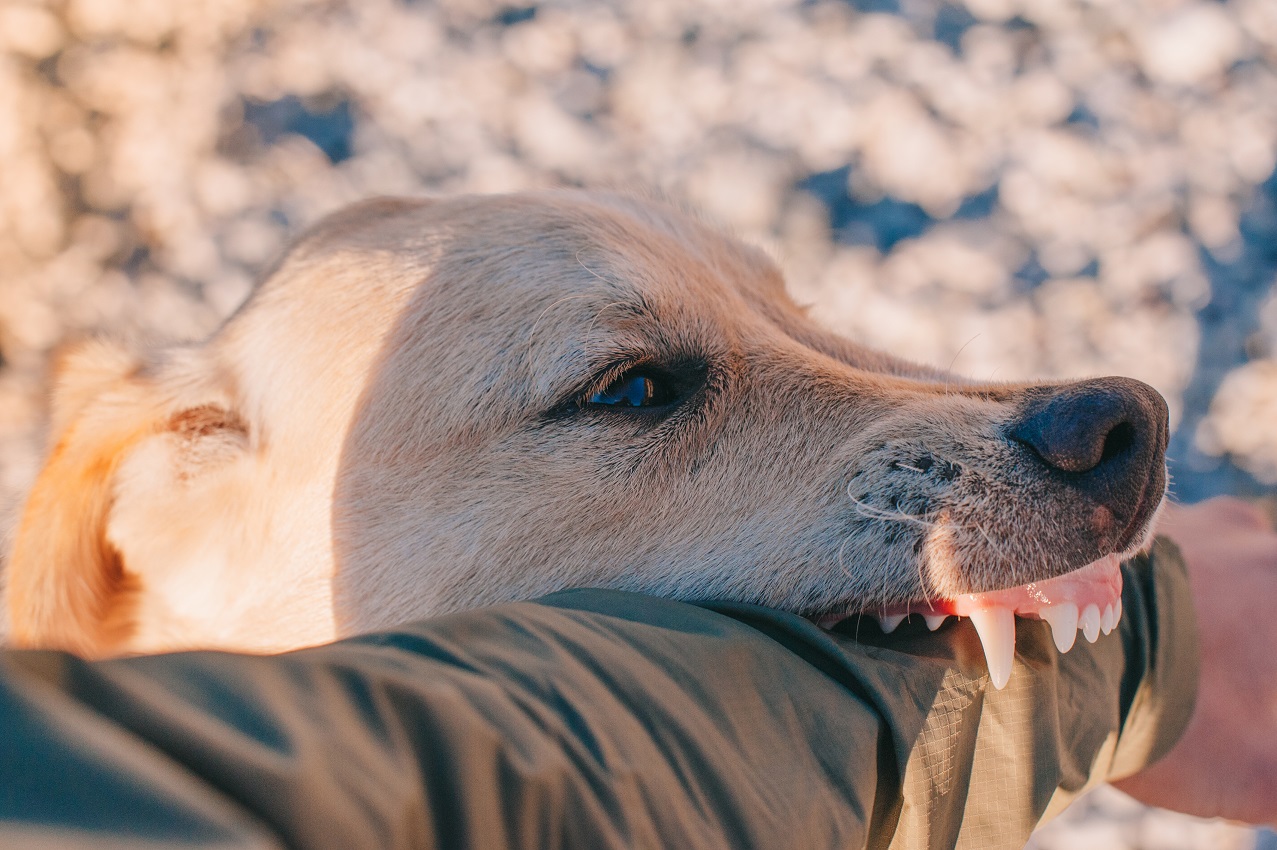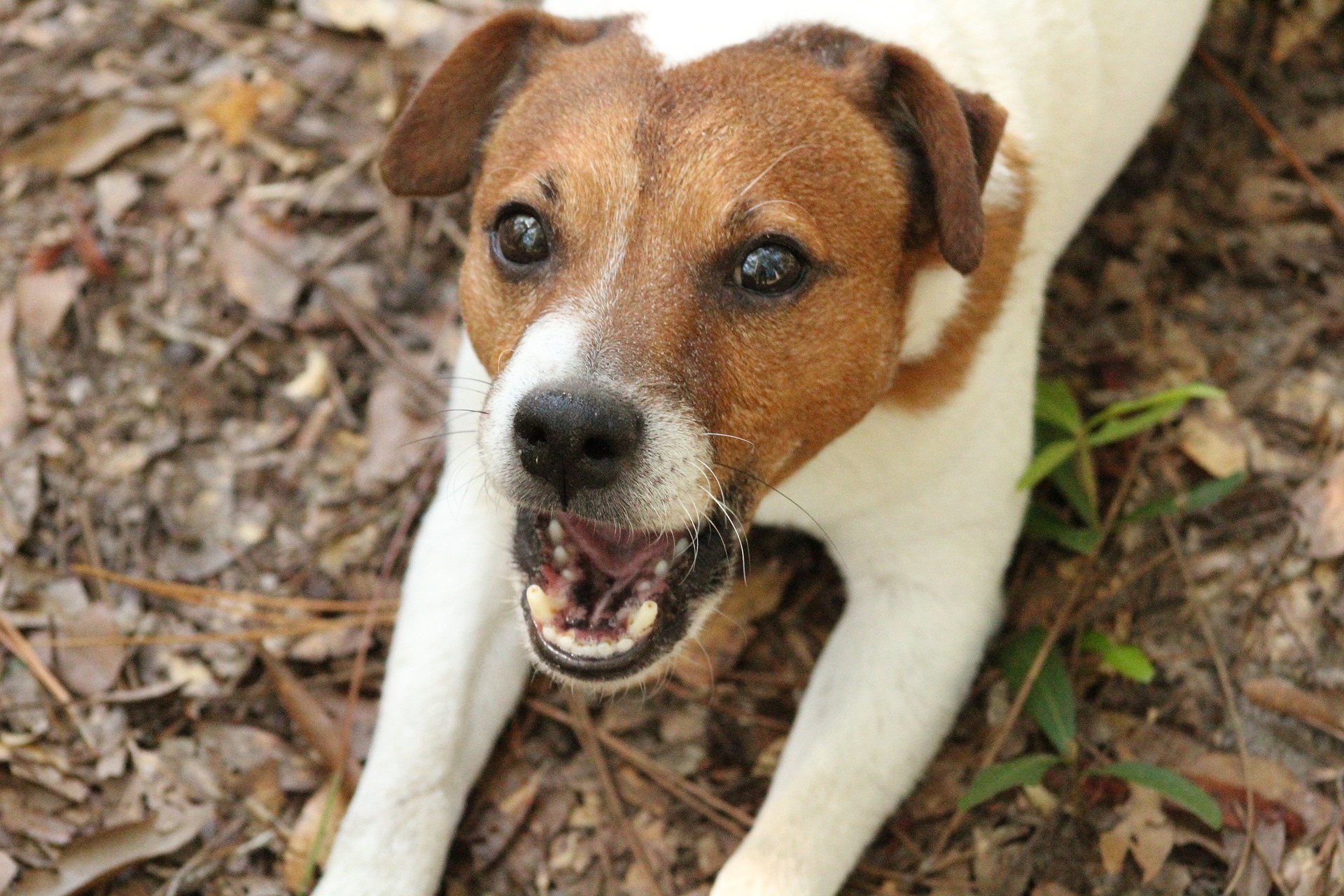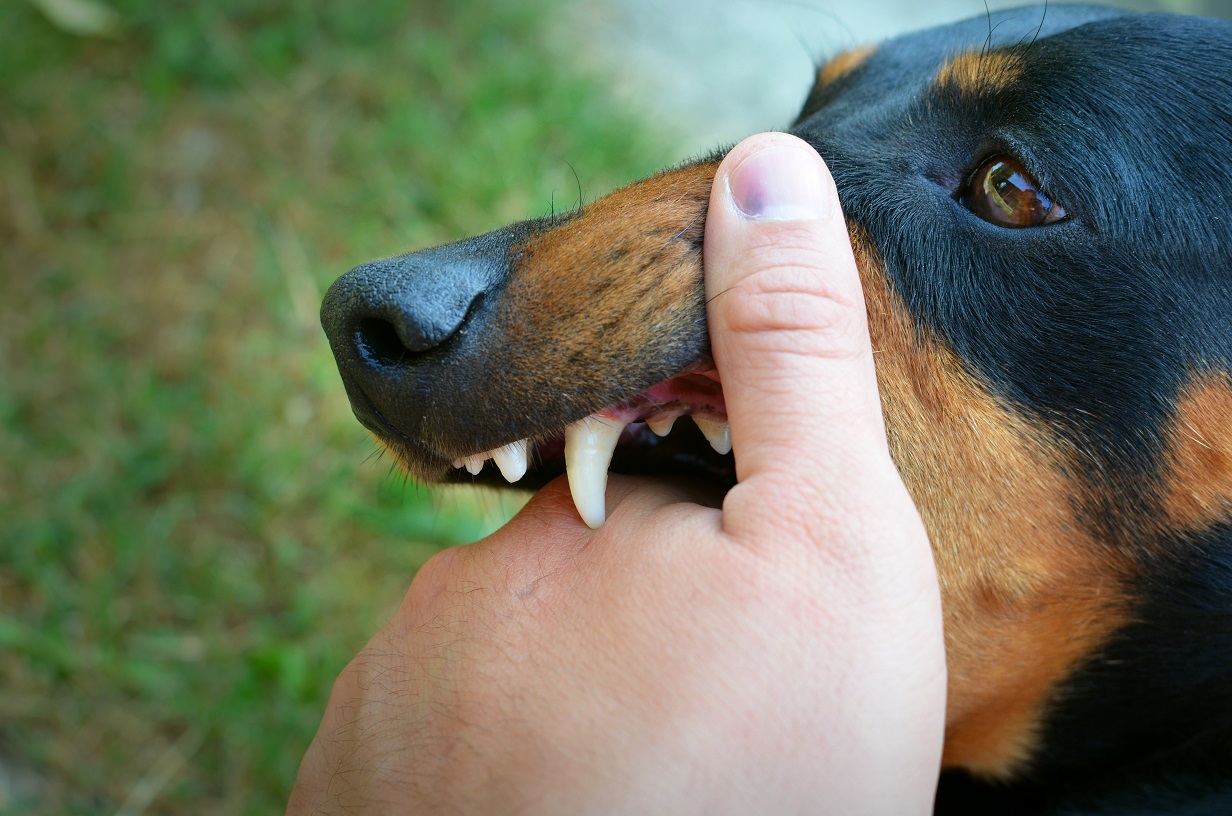“My dog bit someone, should I put him down?…” it’s one of the most difficult questions any dog owner will ever ask. Unfortunately, there’s no easy answer.
Dealing with an aggressive dog is hard. Snarling, lunging, growling… none of those things are easy to deal with. And if those early signs of aggression tip over into an actual bite, the situation becomes even more challenging.
Ultimately, it’s our responsibility as pet owners to ensure our dogs don’t pose a danger to other people.
If your dog has crossed that line, then serious questions need to be asked. And those questions aren’t the kind that can wait.
A dog that bites once isn’t necessarily going to bite again. Maybe there were extenuating circumstances that led your dog to act the way it did.
The problem is, you can’t afford to take that for granted. If your dog has bitten once, you have to assume it might bite again. You also have to take any action that’s necessary to prevent it.
No matter how small or insignificant they might be, dog bites should not… and cannot be tolerated.
…Maybe the last person your dog bit was an adult.
…Or maybe it was more of a nip than a bite.
But what if the next person they bite is a child?
What if the next bite is less of a nip and more of a sustained attack?
Clearly, this isn’t an issue you can afford to sweep under the carpet. But does that mean you should resort to the ultimate step of putting your dog down?
In some cases, it may seem the only viable option. If the aggression is such that it can’t be reasonably managed without severely compromising the dog’s quality of life, euthanasia may be the kindest solution.
However, those cases are rare. Many cases of dog aggression can be managed successfully through training and behavioral modification techniques.
Although the choice is ultimately yours, it’s vital to consider every possible option before reaching your final decision.
Now, before we start delving further into some of the management strategies that aim to tackle aggression, I’d recommend taking a moment to check out the 5 step-by-step calming exercises from Dan Abeldnoor at the Online Dog Trainer. (see video below)
The exercises have been designed to help any kind of dog master the impossible… emotional control.
And regardless of whether your dog’s aggression is rooted in anxiety, fear, instinct, or anything else. Helping them keep those emotions in check can make a huge difference to their behavior.
If your previous attempts at addressing your dog’s aggression have failed, these exercises could well be the missing link in your strategy.
Anyway, here’s the video link to take a look: 5 Step-By-Step Calming Exercises To Stop Your Dogs Scary, Dangerous Biting Habit…
(video will open in a new window)
Why Do Dogs Bite?
Aggression isn’t the kind of problem you can tackle without understanding the root cause first.
Dogs bite for numerous reasons. And understanding the reason in your own dog’s case is a vital first step in figuring out the most effective solution.
So try to understand the context behind your dog’s aggression.
- Does it occur only around certain people or other animals?
- Does it happen when they’re playing with a toy or eating?
- Does your dog have a history of aggression, or has it only developed recently?
The more pieces of the puzzle you can pull together, the easier you’ll find it to identify which of these common reasons for aggression apply.
Fear
A scared dog isn’t one that won’t say boo to a goose. Not always, anyway.
When a dog feels frightened, their flight or fight response kicks in. If there’s no means of escape, they’ll put on an aggressive display that’s designed to make the scary thing go away.
Sometimes, they’ll limit themselves to barking, lunching, and snapping. However, it’s not unusual for a scared dog to bite.
Typically, the problem is most evident in dogs that haven’t been socialized properly.
If a puppy isn’t exposed to a variety of new people, animals, sights, and sounds when they’re young. They can develop extreme phobias and fears of the world as they grow up.
It’s also common in dogs who’ve suffered cruelty or neglect, or those who’ve experienced some kind of traumatic incident.
Resource Guarding
Never underestimate just how much a dog values certain things… nor how far they’ll go to protect them.
If they’ve decided that a toy, their food, or even a person is precious to them, they won’t like it one little bit if anyone tries to come between them.
If your dog tends to become tense, agitated, and aggressive whenever someone approaches them while they’re eating or when they’re playing with a particular toy. It’s an indication of resource guarding.
Although it’s a natural instinct, resource guarding can become extremely problematic if left unchecked, particularly if it’s applied to a person.
Pain
If a dog suddenly becomes aggressive, it could be a sign of illness or injury.
Certain conditions such as epilepsy or other seizure disorders, tumors, vision or hearing loss, and neurological problems can all leave a dog confused, frightened, and prone to lashing out.
If your dog is displaying any other behavioral or physical changes (a change in sleeping pattern, loss of appetite, exercise fatigue, etc.), rule out a medical explanation before anything else.

Territorialism
Once upon a time, dogs were kings of all they surveyed. Those days may be over, but you wouldn’t know it from the way some of them still behave.
When a dog marks out the yard, the house, the car, or even their owner as their territory, anyone who approaches those things suddenly earns ‘intruder’ status.
And if there’s one thing that’s guaranteed to get a territorial dog’s back up, it’s an intruder.
If your dog spends most of their day patrolling the yard or standing watch at the window, it’s likely their territorial instincts run deep.
Although that can be useful in some circumstances (there’s a reason people began breeding guard dogs, after all). It gets less useful and more frightening when the behavior is allowed to develop.
Natural Aggression
No dog is ‘bad’ by nature. However, some dogs have certain instincts that, left unchecked, can become problematic.
Breeds like Akitas, Dobermans, Boxers, Huskies, Mastiffs, and Pit Bulls who are naturally more protective and territorial require plenty of socialization and training to develop into the sweet-natured dogs they’re capable of becoming.
And with too much of the wrong type of influence and not enough of the right type, they can begin to display very undesirable behaviors.
Anxiety
If your dog has only recently started displaying troubling behavior, consider whether something has recently changed in their routine or environment.
As creatures of habit, dogs can get easily stressed if their old routine gets disturbed. A new baby, a new home, or even just a change in your working schedule can be enough to put them on edge.
Once they start to feel anxious and confused, it won’t take much to push them over the edge of reason.
Related Post: What To Do With A Dog That Bites People – 6 Ways To Stop ANY Dog Bite

My Dog Bit Someone. Should I Put Him Down?
When a dog bites someone, it’s hard to think rationally. It’s upsetting, confusing, and scary. With so much spinning around your head, deciding on the right course of action is almost impossible.
But however hard it is, it’s vital to start moving forward. Ultimately, only you can make the final choice. Before you make it, be sure to consider factors such as…
How Big Are They?
It seems almost trivial to suggest that size plays a part in euthanasia decisions, but the reality is, it does.
Small dogs are no less capable of aggression than larger breeds. In fact, certain small breeds like Chiuhahas are notorious for their aggressive tendencies.
But let’s face facts. If a Chiuhaha decides it wants a taste of you, you’re not going to lose an arm. But if a Bull Mastiff decides to make you dessert, you’re not going to have much choice in the matter.
It may sound breedist to say, but size, on this occasion at least, really does matter.
Is the Aggression Predictable?
One of the first things to consider is just how predictable the aggression is.
Did your dog give any ‘warning signs’ such as barking, growling, and snarling before they bit? If they’ve displayed aggressive behaviors in the past, do they usually follow the same pattern?
Most dogs won’t bite without showing signs of discomfort or frustration beforehand. And that’s a good thing.
A dog that gives us a warning can usually be managed through a combination of behavioral modification techniques and training.
A dog that gives no warning, who bites without showing any prior sign of impending aggression, is a different proposition. If an owner can’t predict their dog’s behavior, it’s unlikely they’ll ever feel safe around them.
If that means the dog is isolated and kept from any kind of social interaction, it’s vital to consider just what kind of impact this will have on their quality of life.
Have You Exhausted All Other Options?
Obviously, you know that euthanasia is a last resort. The fact you’re here, if nothing else, is proof that this isn’t a decision you’re taking lightly.
So you really don’t need me or anyone else to tell you how important it is to consider all other options before deciding.
But I’m going to do it anyway. Because it really is that important.
When a dog suddenly starts acting aggressively, it’s easy to lose a sense of proportion.
But now isn’t the time to lose your head.
The more rational, calm, and considerate you are, the less likely you are to make a regrettable decision.
There are many, many alternatives to euthanasia. Not all of them are going to be viable.
Even so, it’s vital to consider them. Ask yourself…

Have You Visited a Vet?
If you haven’t spoken to your vet yet, now’s the time to do it. Aggression can sometimes be down to something as simple (and treatable) as an injury or illness.
Before you go any further down the road, arrange for your dog to be inspected.
If a health problem is to blame for their behavior, a simple course of treatment could be all that’s needed to address the problem for good.
Have You Tried Different Training Techniques?
Behavioral modification techniques like counter-conditioning and desensitization can make a vast difference to a dog’s behavior.
If the aggression is predictable and low-key…
…If your dog is small enough not to pose a threat.
…And if you’re confident in your training abilities, these methods can usually be attempted at home.
If you’re not experienced in training or if you have any concerns for your safety, don’t hesitate to seek professional help.
As a complement to the training, try utilizing different calming techniques.
The 5 step-by-step calming exercises I mentioned earlier can also make a dramatic difference to your dog’s ability to stay calm and focused in even testing circumstances.
As with most things, consistency is key: the more fully you incorporate the exercises into your routine, the more rewards you’ll reap.
Have You Considered Rehoming?
We all want to do the best we possibly can for our dogs. Sometimes, that means taking a step back and realizing that someone else may be able to offer them a more suitable home.
Rehabilitating an aggressive dog through training and behavior modification is often very successful.
But make no mistake – it’s time-consuming, occasionally frustrating, and, if you’re using professional help, costly.
Think honestly about your situation. If you have children, you also need to consider the impact your dog’s behavior may have on them.
There’s no shame in admitting you simply don’t have the resources to manage your dog’s behavior in the way that’s needed.
If your dog will have a fuller life and a better chance at rehabilitation with another family, it’s certainly worth considering.
Related Post: Why Does My Dog Bite Me When I Pet Him? – 5 Reasons Your Dog Bites

Final Thoughts
A dog that bites is a dog that needs help. What shape that help takes is one only you can decide. But remember, you’re not alone in this.
If you’ve been left confused, scared, and anxious by your dog’s behavior, there’s a world of resources, vets, and animal behaviorists who can help you.
So speak to them, weigh up every option, consider every possibility, and think about every potential solution.
Not every dog can be rehabilitated. If the aggression is severe and unpredictable, it might not be possible to manage it in a way that will ensure your safety and your dog’s happenings.
But remember, putting a dog down should always be the last resort. Explore every possible avenue to make sure it’s exactly that.

